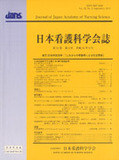Japanese
English
- 販売していません
- Abstract 文献概要
- 参考文献 Reference
要旨
目的:小児看護学実習において学生がどのように子どもの立場に立った看護が実践できるようになっていくのか,そのプロセスを明らかにする.
方法:半構造化面接を看護学生14名に行い,M-GTAで解釈分析した.
結果:29の概念が生成され,7つのカテゴリー〈不安と期待〉〈先行き不安〉〈接近距離の匙加減〉〈促進される子ども理解〉〈高まる援助欲求〉〈必要に応える実践〉〈成長の実感〉が抽出された.さらにコアカテゴリーとして,〈接近距離の匙加減〉〈促進される子ども理解〉〈高まる援助欲求〉によって子ども目線にシフトすることが岐点となり,その過程で《子どもと通じた感》が体得されて子どもの立場に立った看護実践ができるようになる構造が結果図として明らかとなった.
結論:結果図が示した概念・カテゴリーは,学生の学びの状況を把握し,より効果的な学習支援をするための視点として活用できる.
Abstract
Purpose: To clearly identify the process by which students can learn how to provide nursing care from the children's point of view during their pediatric nursing practice.
Method: Semi-structured interviews were conducted with 14 nursing students and the data were interpreted and analyzed based on the Modified Grounded Theory Approach (M-GTA).
Result: The results indicated that there were 29 different concepts generated in the students' learning process. These fall into 7 categories: “anxiety and expectations,” “anxiety over the future,” “adjusting the approach distance with patients,” “promoted understanding of children,” “enhanced desire to assist patients,” “taking action to respond to patients' needs,” and “realizing one's personal growth.” In addition, it was found that “adjusting the approach distance with patients,” “promoted understanding of children,” and “enhanced desire to assist patients” are the core categories in the learning process, and that these are pivotal factors in enabling the students to shift their views to provide care from the children's point of view. Accordingly, we have constructed a diagram that clearly explains the structure of the learning process. In this process, the students experienced a “sense of connection with the children,” which ultimately allowed the students to provide pediatric care from the children's point of view.
Conclusion: The concepts and categories inherent in the learning process that the constructed diagram explains can be used to understand the status of a student's stage in the learning process, and can also be used as a key to provide students with more efficient support for their learning.
Copyright © 2012, Japan Academy of Nursing Science. All rights reserved.


